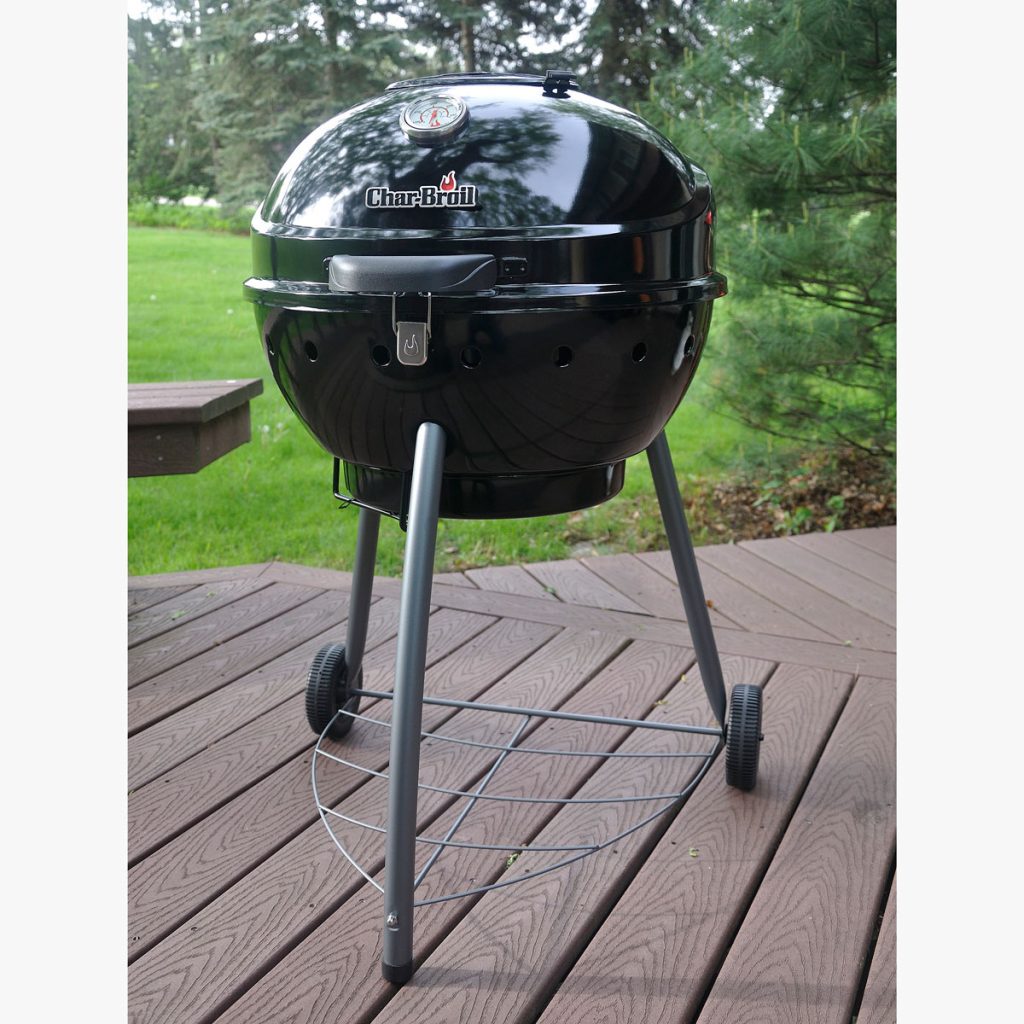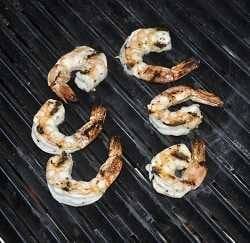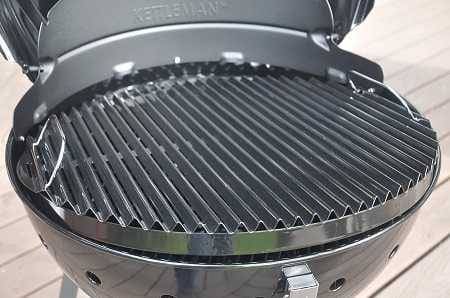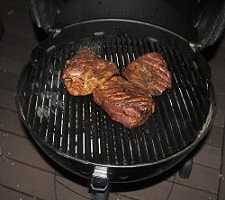YOU ARE HERE >> AmazingRibs » Ratings & Reviews » Char-Broil Kettleman TRU-Infrared 22.5″ Charcoal Grill Review
Char-Broil Kettleman TRU-Infrared 22.5″ Charcoal Grill Review
All of our reviews are done independently by our team of testers and are in no way influenced by advertising or other monetary compensation from manufacturers. Click here to learn more about our unbiased product review process.
Published On: 12/15/2015 Last Modified: 11/5/2025

Forget about hot spots and flare-ups with Char-Broil’s Kettleman Charcoal Grill. You can cover the 22.5″ round grate with greasy burgers and never see a lick of flame from the red hot coals below. Priced just under Weber’s iconic Premium 22″ grill, Kettleman doesn’t succeed in knocking the King from the throne, but offers an easy to use alternative with a couple appealing extras.
We regarded Char-Broil’s TRU-Infrared moniker on this coal burner with a degree of skepticism. Red hot charcoal produces a lot of infrared radiation, but most full size charcoal burners with conventional cooking grates produce a combination of IR radiant heat from the coal, conductive from the cooking grate and convection from hot air inside the cook chamber. Convection heat can rob foods of moisture and flare ups from drippings can dry out, over char and baste foods with creosote. Click here to learn more about conduction, convection and radiation.

Kettleman’s TRU-Infrared design is very different and provides a forgiving cooking experience similar to Char-Broil’s TRU-Infrared Commercial and Performance gas grills. By using a cook surface that is essentially a radiant sheet with raised grates and little direct exposure to hot coal, Char-Broil eliminates flare-ups and hot spots, reduces circulation of dry air convection heat, and provides concentrated radiant heat. The result is even cooking, moist food, less risk of burning and super searing power. Furthermore, small items like shrimp, wings and vegies are spared from falling to a fiery death on red hot coals, (See above).

This unusual 22.5″ round cook surface, (shown above), is a porcelain coated steel disc stamped into a series of upside down V-shaped grates with a thin opening between each. The large surface area, relative to Weber’s steel rod grates, stores and radiates heat energy. Coal rests on a grate just three inches below the cook surface – much closer than other full size grills. The coal tray is integrated into Kettleman’s unique air intake design which was borrowed from Char-Broil’s Dancook Danish grills. The bottom kettle has no adjustable intake vents. Burning coal pulls oxygen in from a ring of one inch holes in the kettle that run the entire perimeter and are flush with the coal grate. There is one large exhaust damper on the hood, (See below).

Did I mention it has a hinged hood? We lifetime Weber kettle men and women will learn to appreciate that feature real fast!

Char-Broil claims Kettleman uses waaaay less charcoal than other grills and there is some truth to this. Because the coal is so close to the cook surface, which itself is a radiant plate that stores heat and reduces the amount of hot convection air that escapes out the top damper, you can use considerably less charcoal. However, one glaring difference between Kettleman and Weber is air control. While Weber is known for tight construction and effective dampers that control air and therefore temperature, Kettleman’s single hood damper has almost no effect. We could not discern demonstrative, repeatable change in temperature from damper settings. In fact, you cannot extinguish coal and save it for the next time by closing the single damper down.
So this unique design allows you to use less charcoal, but in order to save unburned coal for the next time, Charbroil offers this advice: “Get a terra cotta flower pot and two terra cotta flower pot saucers. The saucer should be sized to fit tightly in the top of the flower pot like a lid. Set the flower pot in one of the saucers; scoop the hot coals into the flower pot with a metal fireplace shovel or some such tool. Then put the other saucer on the top of the flower pot and the coals will go out and can be reused. Make sure you put the flower pot on one of the saucers so that hot ashes won’t come out of the hole in the flower pot and burn something.”
The Kettleman Manual gives vague and confusing, counterintuitive instructions to open the damper all the way for lower temp and close it all the way for searing. Char-Broil Tech Support seemed unclear about the damper function as well. We ended up setting the damper half way open and controlling heat solely with charcoal schemes: more or less fuel, direct and indirect zone set ups, and fuse methods for longer cooks. Click here to learn more about these different set ups.
Although it takes some getting used to, especially for those accustomed to Webers, Kettleman works pretty dang good. The heat is very even and flare-ups are non-existent making it a burger lover’s dream come true. We blanketed the grate with 15% fat burgers and there were no hot spots, no shuffling patties around to prevent some from turning black while others were still cooking. The drippings get trapped in the V-Grates instead of falling down and burning up, so after two flights of burgers, we had to scape a lot of gunk off to continue grilling, but at no time did scorching flames rise up to blacken our meat.
Excited by the close, three inch proximity of coal to cook surface, we set up 2-zones and piled on a generous bed under the direct zone to super sear steaks. It was too much of a good thing. Kettleman’s radiant grates quickly branded our steaks with black bars. In this scenario, you definitely can use less charcoal. Three inches isn’t much room and you need to put some space between the coal and the bottom of the grate. Even with the appropriate amount of fuel, Kettleman grates searing performance is similar to cast iron grates, producing pronounced brown sear marks instead of the even brown crust that is attainable with Weber’s thin steel rod grates.
You don’t have to create a thick bed of charcoal. For many coal schemes you can scatter a smaller amount across the coal grate with space between the briquettes. We believe starting charcoal with a chimney is superior to using lighter fluid because the coal lights just as fast, you eliminate using smelly petroleum based fluid and the chimney doubles as a measuring cup to increase consistency. Click here to learn more about starting a charcoal fire. With Kettleman, using a chimney also lets every briquette get red hot and ash over before being scattered. With half a chimney spread across the coal grate, we made a batch of chicken wings. Once again, the heat was very even and the meat retained moisture while the skin crisped nicely.
Kettleman smokes meat beautifully. We made a C-Ring of charcoal around the edge of the coal grate, interspersed with wood chunks and lit one end. The air intake holes line right up with the charcoal and it burned low and slow for several hours with no babysitting. The small BBQ pork butts we made came out tender and moist without the use of a water pan. We attribute this to the reduced effect of dry convection heat. For longer cooks one would have to remove the grate and replenish the circle of coal, or wrap and finish on another device such as a gas grill or kitchen oven.


Kettleman’s hinged lid is a convenient and welcome feature. Who hasn’t occasionally fumbled with a kettle lid while tending their grill? It snaps shut with a latch enabling easy movement on two black plastic wheels. This three legged cooker also includes a small storage shelf integrated into the bottom frame. The obligatory built in heat estimator is even less accurate with Kettleman than other grills, possibly because heat is stored on the radiant plate well below the dome. Do not trust it! You definitely need an accurate digital thermometer for this baby.
The ash removal system is a bit awkward, consisting of an enamel coated steel pan that slides into a frame under the kettle. Not all ash falls directly into the pan and one frequently needs to remove both the cooking and coal grate to brush ash from around the sides into the pan. It’s better than nothing, but not nearly good as Weber’s One-Touch System that allows you to easily scrape all ash into a removable tray without even lifting the hood. Additionally, there is a great deal of contact and friction between the pan and the kettle causing concern that the enamel will eventually wear away opening the door to rust and ruin.
Packaging was excellent, as one would expect from this global BBQ manufacturing giant. However, we noticed some enamel had flaked off the coal grate leading to questions about quality. Yet Kettleman’s warranty is one of the most generous we’ve seen from Char-Broil. In fact it is in line with Weber’s – ten years lid and kettle, 5 years ash pan, and two years for everything else.
Kettleman hasn’t been around long, but early adaptors seem uniformly pleased with their decision to buy it. While we prefer the superior air control and open architecture cooking grate of Weber, those who struggle with charcoal will find relief with Kettlman’s radiant design. It works as advertised; easy to use, no flare-ups, even heat, retains moisture in foods, and the unique air intake holes that surround the coal grate turn Kettleman into a pretty decent smoker without the need for add-on devices.
Click the buttons below to search our complete database of reviews:
Product Information:
-
Model:Kettleman TRU-Infrared 22.5" Charcoal Grill
-
Item Price :150.00
*Price Subject To Change -
Where to buy: ** buying from one of these suppliers will help support this website.
-
Review Method:Cooked On It
We have hands-on experience testing this product. We have also gathered info from the manufacturer, owners and other reliable sources. -
Primary Function:Grill, Smoker, Combination Grill and Smoker
-
Fuel:Charcoal
-
Primary Capacity:Mid-Size (about 17 burgers) : 360 square inches
Manufacturer:
-
Char-Broil

Char-Broil is an innovator in the popular gas grill arena with clever designs, low to midrange prices, and excellent customer service. For several years they have focused on infrared cooking. Starting in 2012 all new IR models were dubbed “Tru-Infrared”. These grills are made with stainless steel tube burners that work in conjunction with a radiant surface to bring heat close to the food. The radiant surface shields food from direct flame and reduces hot dry convection heat rising from the burners.
As one of the biggest BBQ manufacturers in the world, Char-Broil offers a clear, low cost alternative to Weber and surpasses many other price driven manufacturers with their infrared gas grill design innovation and focused marketing. Also in 2012, Char-Broil introduced Saber, a new, very high quality line of gas grills that goes head to head with Weber’s Summit series in the premium grill space. They offer charcoal grills, smokers, fryers and a variety of accessories and tools.
Char-Broil is owned by The W.C. Bradley Company headquartered in Columbus, GA. Roots of W.C. Bradley go back before the Civil War to The Columbus Iron Works. The first Char-Broil grill was made and sold in the USA in 1948. Now all Char-Broil grills are manufactured in China and distributed around the globe.
Related reviews
- Char-Broil 30″ Charcoal Grill Review
- Char-Broil American Gourmet Offset Smoker 300 Series Review
- Char-Broil TRU-Infrared Professional 500 IR Review
-
Max Good, AmazingRibs.com’s Full-Time Grill Tester - Max Good is AmazingRibs.com's Vice President of Product Reviews & Keeper of the Flame and is the world's only full-time reviewer of outdoor cooking equipment including smokers, grills, pizza ovens, griddles, and more.
Up Your BBQ IQ By Joining The Pitmaster Club

Sign up for a free trial of the AmazingRibs.com Pitmaster Club and experience everything that the world’s largest membership-based BBQ and grilling community has to offer!

High quality websites are expensive to run. If you help us, we’ll pay you back bigtime with an ad-free experience and a lot of freebies!
Millions come to AmazingRibs.com every month for high quality tested recipes, tips on technique, science, mythbusting, product reviews, and inspiration. But it is expensive to run a website with more than 2,000 pages and we don’t have a big corporate partner to subsidize us.
Our most important source of sustenance is people who join our Pitmaster Club. But please don’t think of it as a donation. Members get MANY great benefits. We block all third-party ads, we give members free ebooks, magazines, interviews, webinars, more recipes, a monthly sweepstakes with prizes worth up to $2,000, discounts on products, and best of all a community of like-minded cooks free of flame wars. Click below to see all the benefits, take a free 30 day trial, and help keep this site alive.
Post comments and questions below
1) Please try the search box at the top of every page before you ask for help.
2) Try to post your question to the appropriate page.
3) Tell us everything we need to know to help such as the type of cooker and thermometer. Dial thermometers are often off by as much as 50°F so if you are not using a good digital thermometer we probably can’t help you with time and temp questions. Please read this article about thermometers.
4) If you are a member of the Pitmaster Club, your comments login is probably different.
5) Posts with links in them may not appear immediately.
Moderators